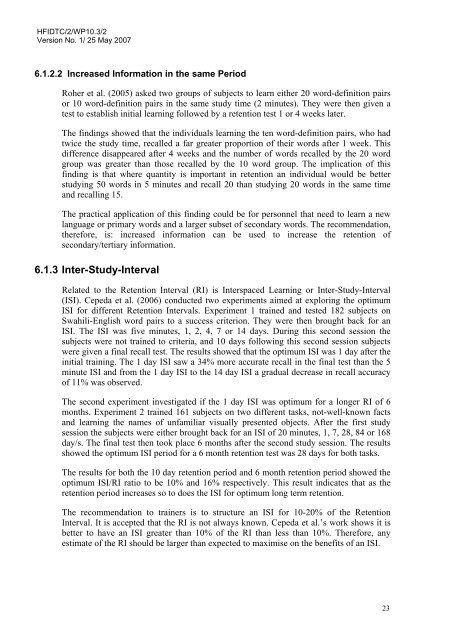Literature Review on Skill Fade - Human Factors Integration ...
Literature Review on Skill Fade - Human Factors Integration ...
Literature Review on Skill Fade - Human Factors Integration ...
Create successful ePaper yourself
Turn your PDF publications into a flip-book with our unique Google optimized e-Paper software.
HFIDTC/2/WP10.3/2<br />
Versi<strong>on</strong> No. 1/ 25 May 2007<br />
6.1.2.2 Increased Informati<strong>on</strong> in the same Period<br />
Roher et al. (2005) asked two groups of subjects to learn either 20 word-definiti<strong>on</strong> pairs<br />
or 10 word-definiti<strong>on</strong> pairs in the same study time (2 minutes). They were then given a<br />
test to establish initial learning followed by a retenti<strong>on</strong> test 1 or 4 weeks later.<br />
The findings showed that the individuals learning the ten word-definiti<strong>on</strong> pairs, who had<br />
twice the study time, recalled a far greater proporti<strong>on</strong> of their words after 1 week. This<br />
difference disappeared after 4 weeks and the number of words recalled by the 20 word<br />
group was greater than those recalled by the 10 word group. The implicati<strong>on</strong> of this<br />
finding is that where quantity is important in retenti<strong>on</strong> an individual would be better<br />
studying 50 words in 5 minutes and recall 20 than studying 20 words in the same time<br />
and recalling 15.<br />
The practical applicati<strong>on</strong> of this finding could be for pers<strong>on</strong>nel that need to learn a new<br />
language or primary words and a larger subset of sec<strong>on</strong>dary words. The recommendati<strong>on</strong>,<br />
therefore, is: increased informati<strong>on</strong> can be used to increase the retenti<strong>on</strong> of<br />
sec<strong>on</strong>dary/tertiary informati<strong>on</strong>.<br />
6.1.3 Inter-Study-Interval<br />
Related to the Retenti<strong>on</strong> Interval (RI) is Interspaced Learning or Inter-Study-Interval<br />
(ISI). Cepeda et al. (2006) c<strong>on</strong>ducted two experiments aimed at exploring the optimum<br />
ISI for different Retenti<strong>on</strong> Intervals. Experiment 1 trained and tested 182 subjects <strong>on</strong><br />
Swahili-English word pairs to a success criteri<strong>on</strong>. They were then brought back for an<br />
ISI. The ISI was five minutes, 1, 2, 4, 7 or 14 days. During this sec<strong>on</strong>d sessi<strong>on</strong> the<br />
subjects were not trained to criteria, and 10 days following this sec<strong>on</strong>d sessi<strong>on</strong> subjects<br />
were given a final recall test. The results showed that the optimum ISI was 1 day after the<br />
initial training. The 1 day ISI saw a 34% more accurate recall in the final test than the 5<br />
minute ISI and from the 1 day ISI to the 14 day ISI a gradual decrease in recall accuracy<br />
of 11% was observed.<br />
The sec<strong>on</strong>d experiment investigated if the 1 day ISI was optimum for a l<strong>on</strong>ger RI of 6<br />
m<strong>on</strong>ths. Experiment 2 trained 161 subjects <strong>on</strong> two different tasks, not-well-known facts<br />
and learning the names of unfamiliar visually presented objects. After the first study<br />
sessi<strong>on</strong> the subjects were either brought back for an ISI of 20 minutes, 1, 7, 28, 84 or 168<br />
day/s. The final test then took place 6 m<strong>on</strong>ths after the sec<strong>on</strong>d study sessi<strong>on</strong>. The results<br />
showed the optimum ISI period for a 6 m<strong>on</strong>th retenti<strong>on</strong> test was 28 days for both tasks.<br />
The results for both the 10 day retenti<strong>on</strong> period and 6 m<strong>on</strong>th retenti<strong>on</strong> period showed the<br />
optimum ISI/RI ratio to be 10% and 16% respectively. This result indicates that as the<br />
retenti<strong>on</strong> period increases so to does the ISI for optimum l<strong>on</strong>g term retenti<strong>on</strong>.<br />
The recommendati<strong>on</strong> to trainers is to structure an ISI for 10-20% of the Retenti<strong>on</strong><br />
Interval. It is accepted that the RI is not always known. Cepeda et al.’s work shows it is<br />
better to have an ISI greater than 10% of the RI than less than 10%. Therefore, any<br />
estimate of the RI should be larger than expected to maximise <strong>on</strong> the benefits of an ISI.<br />
23
















